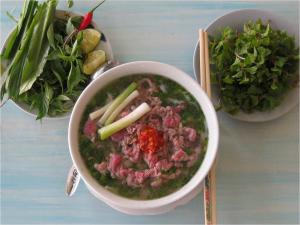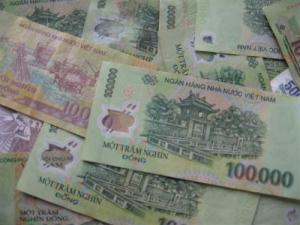Phở - A Bowlful of Vietnamese History, Culture and Huge Flavors

When speaking of Vietnamese food, one name will always be in the picture, and in fact, because of its popularity, is well-talked about, praised and even glorified by many. An easy dish to pick up and enjoy, hearty, delicious, warm and comforting, Phở (often written Pho) is, and will always be, considered the perfect food that cheers not just one’s appetite, but the heart as well.
Known as Vietnam’s national soup, this rice-noodle dish served in a flavor-packed broth may seem very simple to one’s eyes, but every bowl of Phở is loaded with complex flavors that delights the taste buds of anyone who acquaints himself to this pleasantly satisfying treat.
In Vietnam, Phở is the common people’s food, found in every home. Whether you walk along broad or narrow streets, all over the country you could see hungry people crouched on tiny stools slurping every bit of their Phở. At the same time Vietnam’s finest restaurants serve the very same great-smelling bowls of this wonderful dish to their well-heeled customers seated at cloth-covered tables while talking about market, stocks and trade.
In its entirety, Phở mirrors the lives of the Vietnamese along with their colorful heritage as this dish is greatly steeped in the country’s tradition and closely tied to its history from the last century.
History of Phở
But as to how Phở came up, no one is truly certain about the specifics. In fact, there aren’t really many written records or past documents uncovered about Phở. Scholars, chefs, diners and many Phở fanatics, however, agree that this dish was invented in the early part of the 20th century in northern Vietnam.
A couple of theories point to Nam Dinh province (southwest of Hanoi) as the birthplace of Phở, and that ingenious cooks from the locality invented the dish to satisfy the zest for good food of its residents, both Vietnamese and French. With the use of local ingredients, du boeuf was added to the soup to create a local-tasting soup with a touch of foreign flavors. In another theory, the history of Phở is traced back to Van Cu, a small impoverished village still in the Nam Dinh province. Suggesting that it was in the village where the first bowl of Phở was invented, yet as a means of survival, its residents peddled the delicious soup for several miles to Hanoi. Though not substantiated, many of the present vendors in the capital are in fact from that village.
But the concept of incorporating noodles, broth and meat into a single bowl is a product of Chinese and French influences. By no debate, the Viet culture demonstrates strong Chinese influences. Rice noodles and spices, used at the time Phở when was created, were imported from China. Yet, as the French popularized the eating of red meat, it is from them where the idea of adding in beef (and later on chicken) to the bowl came about. It is even believed that Phở is derived from a French beef stew, named “pot au feu” which describes certain similarities in its preparation such as the use of beef bone marrow for its broth, the spices and flavors added as well as the length of time employed in cooking. However, with the Vietnamese spontaneity in making clever dishes, native cooks interjected their own concept and came up with the now Phở. So regardless of the origin, Chinese or French or both, all these along with native influences make the perfect blend of a dish that is uniquely Vietnamese.
The Popularity of Phở
Phở, after it was discovered, took off like a wildfire and its popularity spread southwards beginning 1954 when Vietnam was divided into North and South. As it moved towards the South, smart cooks made several attempts to develop the raw beef version of Phở (Phở bò tái) and the chicken Phở (Phở Gà), and especially during the periods where beef was scarce, they came up with the pork Phở. Though still, many of the variations maintains the beefy character of Phở, and after periods of infusing added ingredients into the basic boiled beef, noodles and broth, Phở evolved into the version that is commonly served today. Phở quickly became the national dish for all seasons.
Invading the Global Scene
After the end of the Vietnam War in 1975, the Vietnamese fled to different parts of the globe. To every country they immigrated, they did not only bring along their hopes and dreams of a better life, but also their colorful cultures and unique cuisine. Since then, Vietnam’s national dish started to grace the tables of different cultures around the world.
With the large Viet community in the United States, many Americans have acquainted themselves to Phở. Not only do they find goodness in every bowl as they see it as a very healthy meal that is so rich in flavor, the Americans also admire the exquisite art of making the dish. The popularity of Phở in France is undeniable as well, and by no doubt, it had captured the taste buds of other countries like Canada, Korea, Malaysia and Singapore. Filipinos are known as adventurous eaters and with a strong craving for great food. Their country is considered a melting pot of different cuisines and Phở is among the many dishes trying to fancy its people’s fickle taste buds. Though the dish has not yet taken strong roots in their country, its presence has been beginning to be strongly felt. At present, there is now a certain number of Phở fans in the Philippines showing tremendous acceptance to the unique dish.
The diverse character of Phở makes it easily admired and embraced by many.
What Makes Up the Phở
Unique as the Phở already is, another great quality about this soup is the varying techniques employed in cooking the dish. So to speak, no two bowls of Phở served from two separate kitchens will ever taste the same. However, all Phởs in the world are made up of the very same three elements that makes a bowl complete: the broth, the rice noodles and the meat.
But then again, no matter where the Phở is cooked, and no matter that no bowl could ever be exactly the same, there is only one distinct taste of the Phở broth. Considered the soul of the dish, many agree that a successful bowl of Phở is the creation of good broth. Phở fanatics and the most discern diners judges the quality of a bowl of Phở by having a sip of its broth before any garnishing had touched the whole dish.
There may be no single perfect technique for creating the best Phở broth, but all Phở recipes call for the following ingredients:
Yellow onions
Ginger
Star Anise
Cloves
Salt
Fish Sauce
Sugar
Carefully-selected beef bones (marrow-rich bones and knuckle bones)
Boneless beef chunks
Generally, two stockpots of boiling water are needed for the preparation. Both the beef bones and boneless chunks are parboiled in one pot over high heat for about 5 minutes to take out the excess fat and all the impurities. Depending on different cooks, while some prefer to rinse off the meat and bones before moving them to the second pot, others leave it unwashed. While on the second pot, everything is kept at a simmer for an hour and a half. Any scum rising to the top is ladled out from time to time. Char the garlic and onions in open flame and the spices are then either tossed or wrapped in cheesecloth. The beef chunks are taken out after 90 minutes, while the rest of the broth is allowed to simmer much longer. When done, the broth is strained to come clear from impurities and is seasoned with sauce, salt and sugar before poured over the unseasoned rice noodles and boneless beef set aside earlier.
As techniques may vary one way or another, some would even simmer the broth up to more than 12 hours for the bone marrow to perfectly dissolve into the water, which is the very essence of the broth itself.
While there is no denying that the Phở broth is the most important element of the Vietnamese Phở, its rice noodle plays an equally important role. If the broth is the soul, the Bánh Phở noodle is the body of the Phở dish itself. The very noodle used in every bowl of Phở, Bánh Phở is made of rice flour which comes in different widths, and could either have rectangular or square cross-sections. Other countries call it chantaboon or rice sticks. The Bánh Phở is sold as drily packaged and widely available in supermarkets. However, many believe that fresh Bánh Phở adds to the quality of a great Phở.
Adding Finishing Touches
There are essentially two things you need to do before digging into your bowl of Phở. Add the garnishing, and then add the sauce. There is no strict rule as to what you must or what you must not add to your Phở since garnishing your bowl is more like putting together your own sandwich - toss in whatever you wish and have it whichever way you want.
So once your Phở is served on the table, you can go ahead and do your thing. Among the popular garnishes people mostly include in their Phở ritual are:
Bean sprouts - Freshly added or slightly blanched, they are popular for enhancing the flavor of Phở and if taken rawly, the crunch that comes with it could be lots of fun.
Herbs – freshly stripped from their stems and dropped straight to your bowl gives more character to your Phở. Every herb could introduce a different flavor and aroma. Many use the chopped cilantro (ngo gai in Vietnam) because of the nice, pleasant fragrance it gives out. The purple-stemmed Asian/Thai basil adds a tempting, sweet smell to your bowl. Spearmint could also make some twist not just to the flavor, but to the scent as well.
Lime – many would prefer adding a squeeze of lime to tame the sometimes too sweet or too salty broth. Even if it comes bland sometimes, lime somehow brings the broth to life.
Chiles – a thin slice of hot chile, either dipped or mixed into the Phở, releases the oil from the hot broth. Popularly used are Thai bird chiles and dragon chiles, or if not, serranos or jalapeños will do.
Your table where your Phở is served would never be complete without the sauce. Whatever you fancy, you could go for the hoisin sauce, hot chili sauce, Sriracha hot sauce, bo vien or whatever your taste buds dictate. Once satisfied, go ahead and start digging and slurping your bowl to its last drop.
The Many Faces of Phở: within Vietnam and in other Regions around the World
Being rooted in northern Vietnam and having spread down south, there are distinctly key variations in their Phở. With fewer chunks of meat, tiny slices of ginger on the top, and served only with green chiles and lime, none of the bean sprouts or herbs, how people make their Phở in the north is a lot simpler and with lesser ingredients than that of the south. More complex, southern style Phở typically comes with bean sprouts, fresh basil and cilantro in every bowl.
As Phở became widely accepted throughout different parts of the world as the essence and symbol of Vietnamese cooking, Phở has now reached out far and wide from the tiny stalls of Hanoi to every habitable continent in the world.
Phở may have influenced the American’s taste buds one way or another. On the other hand, the soup itself has also been influenced by the Americans and the American way of life. An American bowl of Phở is about 30 percent bigger than those you find along the sidewalks of Vietnam. Just as how they serve their other dishes, which come in large portions, they have somehow “americanized” the dish in such a way while retaining its Vietnamese character. American Phở restaurants offer a wide variety of options, as well to personalize their bowls, reflecting the American independent spirit. Thus, choices from raw beef, cooked beef (such as brisket, flap or outside flank), tendon, tripe and meatballs are available.
As part of the Buddhist religious observance, a strict non-meat variety of Phở is developed, thus, gave birth to vegetarian Phở (Phở Chay). This variety is also popular to those who have to stick to veggies for health reasons, or simply as a personal choice. With Phở’s growing popularity in the United States, finding the vegetarian Phở in the menus of their Phở restaurants is expected.
In France, while Phở is served in many restaurants throughout, the dish is especially famous in Paris’ Chinatown. While their Phở tastes pretty similar, yet is packed with more beef, anyone can opt to order a petit bowl or a grand bowl.
As Phở has swept all across the world, an authentic Vietnamese joint offering this dish normally serves the authentic version with broth made from beer of chicken bones. Though the two main types (beef Phở and chicken Phở) leads their menu, everyone seems to have adapted the changing times, and now, it is common to come across vegetarian Phở, semi-vegetarian Phở, shrimp Phở, seafood Phở and many other interesting varieties.
But the diversity of Phở didn’t quite end here. If you take a quick tour across the supermarkets and groceries, you will realize that their shelves hold quite a number of brands of instant Phở. Though many people may frown on the concept of any instant food, claiming it doesn’t really come with the greatness of the 12-hour simmered Phở from the kitchen, some would settle for ‘not the real thing’ due to a variety of reasons, including economic. Undeniably, these instant noodle packs are indeed affordable. Students living in tiny, sparsely equipped dorms, or anyone who enjoys the convenience of a quick fix, the instant Phở caters their need to satisfy hunger in less than five minutes. For Vietnamese who live outside places serving Phở, the comfort of connecting with their culture, no matter whether it is something from an instant noodle cup or freshly made, still gives them an ‘at-home’ feeling.
Bringing Phở to Your Home
In Vietnam, even people who know how to fix Phở in their kitchens do not actually bother to make the dish anymore at home because they know it is far easier and definitely a lot cheaper, just to walk around the corner and choose among the stores along the streets that have the best-smelling Phở.
But as Phở had gone so far beyond its borders, many non-Vietnamese have fallen in love with Vietnam’s national soup and are learning to cook Phở in their own kitchens. Thanks to the availability of many good Phở recipes around the internet, people can now explore and enjoy the one-pot meal in their own homes.
Not to forget what every Phở recipe says, though: always cook good beef bones, keep your broth clear and never dilute it. Everything boils down to always making a great broth, and once you have that, the rest should just fall into place.
Connecting with its Roots
As the nourishing beef broth serves as the soup, the rice noodles as the starchy element, the meats as the protein, while the herbs, vegetables and other garnishing could pass up as salad as in regular meals, the Vietnamese Phở is in fact a complete meal in a bowl.
Now with numerous Phở chains and franchised Phở restaurants all throughout it is no longer an ethnic food confined in the streets of Vietnam. But whether you are learning to make Phở in your own kitchen, dine in a restaurant or noodle bar, wherever tables around the world serve this dish and to which culture it might be introduced to - every bowl of Phở will always translate the warm and comforting character of the Vietnamese people, their diversely rich culture and an important part of their country’s unique and interesting history.









